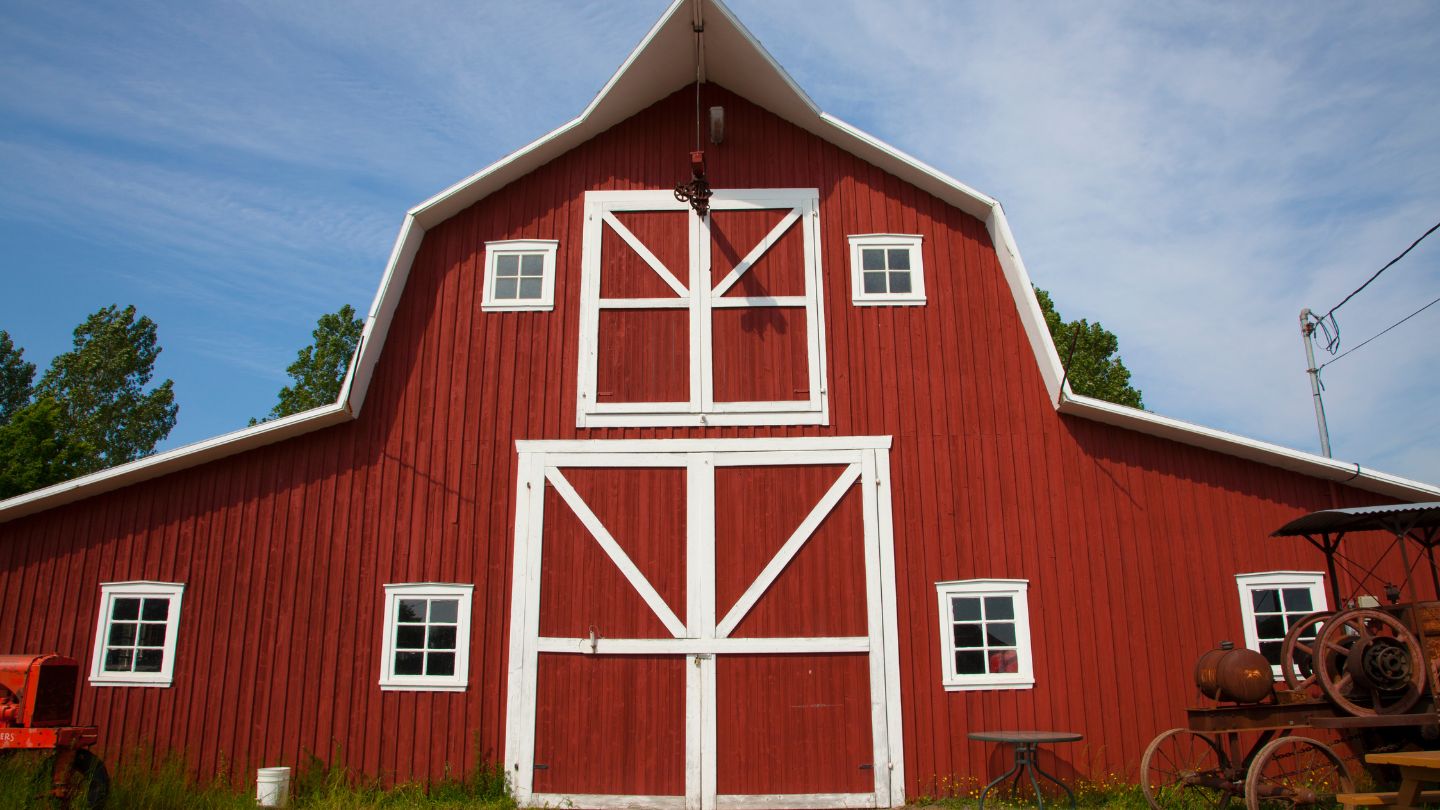How to Heat a Barn in Winter: Effective Solutions for Cold Weather
Home
Blog
- How to Heat a Barn in Winter: Effective Solutions for Cold Weather
Need to keep your barn warm this winter? This guide on how to heat a barn in winter will show you the best ways to insulate, choose heaters, and maintain warmth efficiently.
Key Takeaways
- Understanding specific heating needs for various livestock is crucial for their health and comfort in winter.
- Effective insulation, particularly using spray foam and vapor barriers, significantly enhances heat retention and reduces heating costs.
- Proper ventilation is essential for preventing moisture issues and maintaining a healthy environment within the barn.
Understanding Barn Heating Needs
The requirements for heating in barns are determined by various elements such as the structure’s dimensions, the standard of insulation, and window count. More extensive barns that lack adequate insulation and feature a high number of windows require heftier heating systems. Providing heat within a barn is crucial not just for comfort but also for ensuring animal welfare and preventing damage to equipment.
Livestock species each have distinct needs when it comes to warmth.
- Smaller creatures like birds require additional heat once external temperatures fall beneath 40°F.
- For dairy cows, an ideal range lies between 41°F and 77°F.
- Animals at younger stages need warmer conditions that remain more consistent than their older counterparts.
Comprehending these particular demands is essential to secure your livestock’s overall health.
Due to their expansive size and specific design features, barns pose unique challenges in terms of heating. Utilizing heaters that are too small can result in discomfort along with potential health risks for animals housed inside them. Enhancing winterization efforts through fixing gaps and improving insulation significantly benefits heat conservation effectiveness within the space. Keeping all these considerations in mind when selecting a heater will aid you greatly in addressing your specific thermal requirements efficiently within your own barn setup.
Insulation: The First Line of Defense
Ensuring your barn is well-insulated is a critical element of an efficient heating system. Insulation acts as the main defense against losing heat, which can greatly diminish heating costs. If insulation isn’t adequate, a considerable amount of the warmth generated by your heating system will be lost, resulting in steeper heating bills and reduced comfort for animals.
Professional insulation installation is essential to maximize efficiency. Experts use high-performance materials, such as spray foam, to seal cracks and crevices. Spray foam excels at filling gaps and preventing drafts while retaining heat, making it an excellent choice for barns. Moreover, adding a vapor barrier professionally prevents humidity-related deterioration and ensures the insulating layer remains effective over time.
A comprehensive insulation service includes inspecting and sealing air leaks around doors, windows, and joints. This guarantees optimal heat retention throughout the barn. Post-construction improvements, such as professionally applied weatherstripping or reinforced insulation layers, also enhance heat conservation. Relying on experts ensures the job is done thoroughly and effectively.
Choosing the Right Barn Heater
Selecting an appropriate heating system is essential to create a warm and inviting atmosphere in a barn. A multitude of heating alternatives exist, comprising forced air systems, infrared heaters, and general barn heaters – each with unique strengths and drawbacks. It’s crucial to match the choice of heater to the individualized requirements of your specific barn.
Infrared heaters are an excellent option for spot heating, as they deliver radiant heat directly to surfaces and animals without wasting energy on heating the air. These systems are often quieter and more energy-efficient when installed professionally. On the other hand, forced-air systems distribute warmth evenly across large spaces but require expert setup to ensure proper airflow and avoid energy inefficiency.
Professional installation is key to selecting and implementing the right heating system for your barn. Trained technicians consider factors such as local weather conditions, the structure’s insulation level, and the specific heating requirements of your livestock. They can also design and integrate heating solutions seamlessly, ensuring efficient operation and long-term reliability.
Supplemental Heat Sources
Under certain circumstances, additional heating is essential to ensure that your animals are sufficiently warm. This is particularly pertinent in areas experiencing harsh cold weather and for smaller species such as chickens and rabbits. Professionals can recommend and install supplemental heating systems tailored to your barn’s unique needs, such as heated water troughs, electric heaters, or zone-specific heat sources.
Instead of relying on low-tech or DIY solutions like tubs of hot water or heated bricks, which pose safety risks, professionals focus on safe, efficient supplemental heating methods. For example, thermostatically controlled heaters can be strategically installed to provide consistent warmth without compromising safety.
Additionally, experts can ensure that water troughs are equipped with reliable heating mechanisms to prevent freezing, maintaining a steady supply of drinking water for livestock. Trusting professionals for supplemental heating solutions not only reduces risks but also ensures a consistently warm and safe environment for your animals.
Heating Specific Areas of the Barn
In order to maintain optimal conditions, targeted heating is necessary in certain sections of the barn. The vet room, quarantine area, milking room, and water tank are critical zones where heating should be prioritized. To ensure these areas are efficiently heated, it is best to engage professionals who can assess and design custom solutions for each space.
For instance, the water tank requires specialized heating to prevent freezing. Experts can install energy-efficient water tank heaters with safety features to ensure uninterrupted access to drinking water. Similarly, professional-grade heating systems for tack rooms protect equipment from cold-induced damage while maintaining the room’s usability.
Sick or injured animals and young ones require extra care, and tailored heating solutions can address their specific needs. For example, zoned heating systems can create warm microenvironments for these vulnerable animals, ensuring their comfort and recovery. A professional approach ensures these critical areas are heated effectively and safely.
Ventilation is Key
Ensuring that the barn is equipped with sufficient heating is critical, yet providing adequate ventilation holds equal importance for fostering a healthy environment. Proper airflow helps ward off moisture-related issues, which can cause respiratory ailments in horses and hamper mold formation while accelerating the drying process of stalls.
Professionally installed ventilation systems are designed to maintain optimal air quality and humidity levels. Experts can install adjustable louvers, exhaust fans, and air circulation systems that ensure fresh air flow while minimizing heat loss. These systems are calibrated to maintain humidity at around 60 percent, which is ideal for livestock comfort and health.
An effective ventilation system also reduces ammonia buildup from animal waste, safeguarding the respiratory health of your livestock. With the guidance of professionals, you can establish a barn environment that balances warmth, ventilation, and overall well-being for your animals.
Professional Installation and Maintenance
Ensuring the safety and efficiency of heating systems through professional installation is critical. Engaging skilled experts in this field can help avoid issues that might endanger livestock well-being. When a heating system is installed properly, it not only works more efficiently but also reduces heating costs while creating a warmer setting for your animals.
Utilizing professional assistance guarantees that the installation and upkeep of your barn’s heating system meets top-notch standards.
Reducing Heating Costs
Many barn owners prioritize lowering their heating expenses, especially during the brisk winter months. Professional services can help optimize energy efficiency, reduce waste, and minimize costs. Experts can recommend energy-efficient heating systems, such as programmable thermostats and zoned heating systems, which adjust warmth according to the specific needs of each area.
Energy audits by professionals can identify areas of heat loss and inefficiency, enabling targeted improvements. Consolidating animals into a specific section of the barn, as advised by experts, reduces the volume of space requiring heating and significantly cuts costs. Routine HVAC maintenance performed by skilled technicians ensures systems operate at peak efficiency and avoid unnecessary energy expenses.
These strategies, implemented with professional support, help manage energy consumption while maintaining a warm and safe environment for your livestock.
Ensuring Livestock Comfort
Ensuring the comfort of your livestock during the winter is essential for their health and well-being. Professional services can enhance livestock comfort by providing customized bedding solutions and heating systems tailored to specific needs. Deep, professionally installed bedding layers of 6-12 inches, combined with advanced insulation methods, can keep animals warm and inhibit bacterial growth.
Grouping animals in optimized enclosures designed for heat conservation can also enhance warmth. Professionals can assess and recommend dietary adjustments, such as increasing hay and grain intake for horses, to ensure sufficient energy levels for maintaining body heat. These tailored approaches by experts guarantee a warm, safe, and healthy environment for your livestock throughout the winter.
Summary
Creating a warm barn during the frigid winter months necessitates a strategic approach involving expert insulation, targeted heating systems, and effective ventilation. By adopting these methods, you can guarantee a safe and comfortable environment for your livestock while maximizing energy efficiency.
Bradford Crafted excels in barn construction in Alpharetta, providing tailored solutions that enhance your barn’s heating system and overall functionality. Our expertise ensures your barn is ready to face the cold temperatures ahead. Reach out to us today, and let us help you create a cozy retreat for your animals!
Frequently Asked Questions
1. How do I choose the best heating system for my barn?
Consider your barn’s size, insulation, and the specific needs of your livestock. Consulting a professional ensures the system is properly matched to these requirements.
2. What’s the safest way to prevent water troughs from freezing?
Using heated water troughs or professionally installed heating elements ensures consistent access to water without the risks associated with DIY methods.
3. How can I improve heating efficiency without increasing costs?
Focus on enhancing insulation, sealing gaps, and using programmable heating systems to target specific areas and minimize energy waste.
Table of Contents
Recent Blogs
Top Qualities to Look For in A Composite Deck Contractor
Searching for a composite deck contractor? Knowing the essential qualities to prioritize when selecting a company is crucial to ensure [...]
4 Great Reasons You Should Renovate Your Basement Today
Thinking about renovating your basement? Here are four great reasons you should renovate your basement now. Turning an underutilized space [...]
Top Things to Consider When Building a Porch in Milton
Planning to build a porch in Milton? There are several important things to consider when building a porch in Milton, [...]







